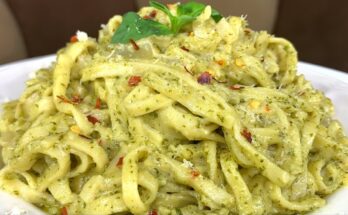Sauteed Shrimp Recipe: If you’re looking for a quick, flavorful, and healthy dish to whip up in under 20 minutes, then this sauteed shrimp recipe is your golden ticket. Shrimp cooks fast, absorbs flavors beautifully, and adds a touch of gourmet to any meal. Whether you’re cooking for a casual dinner or entertaining guests, this recipe is guaranteed to wow your taste buds.
Introduction to Sauteed Shrimp
Why Sauteed Shrimp is a Crowd-Pleaser
Shrimp is one of those ingredients that appeals to nearly everyone. It’s light, succulent, and has a mild, sweet flavor that pairs well with almost anything—from garlic and herbs to spicy peppers and tangy citrus. When sautéed, shrimp gets a beautiful golden sear while staying juicy inside. It’s also incredibly versatile—serve it over pasta, rice, salad, or even tacos.
Ideal Occasions for This Recipe
Sautéed shrimp shines on weeknights when you need dinner fast but still want something satisfying. It’s also great for weekend brunches, meal prep for busy weeks, or even as a fancy appetizer at your next gathering. You can dress it up or keep it simple—either way, it’s always a hit.
Ingredients You’ll Need
To get the best sauteed shrimp, you’ll need fresh, high-quality ingredients. Here’s your go-to list:
- 1 lb shrimp (peeled and deveined)
- 2 tbsp olive oil or butter
- 3 cloves garlic (minced)
- Juice of 1 lemon
- Salt and pepper to taste
- Fresh parsley or cilantro (for garnish)
Fresh vs Frozen Shrimp
Fresh shrimp is ideal, but frozen shrimp works just as well—just make sure it’s properly thawed and dried before cooking. Patting it dry ensures a good sear and prevents the shrimp from steaming in the pan.
Optional Add-ins for Flavor Boost
Want to take it up a notch? Consider adding:
- Crushed red pepper flakes for heat
- Paprika or smoked paprika for depth
- A splash of white wine for a gourmet twist
- A sprinkle of Parmesan cheese for richness
Preparing the Shrimp
How to Properly Clean and Devein Shrimp
Cleaning shrimp might sound tedious, but it’s worth the effort. Here’s how to do it:
- Rinse the shrimp under cold water.
- Use a small paring knife or shrimp deveiner to make a shallow cut along the back.
- Gently remove the black vein using the tip of the knife or your fingers.
- Rinse again and pat dry with a paper towel.
This process not only improves flavor but also ensures a more pleasant texture.
Marinating Tips for Extra Flavor
While it’s not strictly necessary, marinating the shrimp for 10–15 minutes can really boost the flavor. Try a mix of olive oil, lemon juice, garlic, and herbs. Keep the marinade simple and short—shrimp can become mushy if marinated too long due to its delicate protein structure.
Cooking Equipment Essentials
The Best Skillet for Sautéing
A large, heavy-bottomed skillet is perfect for sauteing shrimp. Cast iron or stainless steel holds heat well and helps develop that beautiful sear. Avoid nonstick pans for this recipe—they often prevent proper browning.
Cooking Tools That Make a Difference
- Tongs or a spatula for flipping shrimp without breaking them
- A microplane for zesting lemon or grating garlic
- A small bowl for mixing marinades
- A sharp knife for prep work
These tools may seem basic, but they’ll streamline your cooking process and ensure better results.
Step-by-Step Cooking Instructions
Heating the Pan Correctly
Before you even think about adding shrimp to the pan, get that skillet hot. Add olive oil or butter and let it heat until shimmering. This ensures the shrimp cooks quickly and gets a nice sear.
Sautéing the Shrimp to Perfection
- Add shrimp in a single layer—don’t overcrowd.
- Let them cook undisturbed for 1–2 minutes.
- Flip and cook for another 1–2 minutes until pink and opaque.
Knowing When Shrimp Is Done
Shrimp is done when it turns pink and forms a loose “C” shape. Overcooked shrimp curls into a tight “O” and becomes rubbery. Aim for that “C” for perfect texture every time.
Serving Suggestions
Best Side Dishes to Pair
The beauty of sautéed shrimp is its versatility. Whether you’re planning a light lunch or a full dinner, there are countless sides that pair beautifully with this dish:
- Garlic Butter Rice: The subtle flavor of rice complements the rich shrimp perfectly.
- Lemon Pasta: Toss some cooked linguine with olive oil, lemon zest, and a sprinkle of Parmesan.
- Grilled Vegetables: Bell peppers, zucchini, and asparagus make a colorful and nutritious pairing.
- Crusty Bread: Mop up all that garlicky, buttery goodness with warm, crusty bread.
Want to keep it low-carb? Go for a fresh garden salad or cauliflower rice. You can also serve the shrimp in tacos, over polenta, or even in lettuce wraps for a fun twist.
Presentation Tips for Impressing Guests
We eat with our eyes first, right? So don’t forget the presentation. Here are a few quick tips:
- Use a white plate to let the shrimp’s vibrant color pop.
- Garnish with fresh herbs like chopped parsley, cilantro, or dill.
- Add a lemon wedge on the side for a burst of color and flavor.
- Drizzle a little olive oil or garlic butter over the top just before serving.
Bonus points if you use a cast iron skillet straight from stove to table—it’s rustic, stylish, and keeps the shrimp warm longer.
Variations of Sauteed Shrimp
Spicy Cajun Style
Craving some heat? Cajun-style sautéed shrimp is bold, zesty, and incredibly addictive. Just toss your shrimp in a mix of Cajun seasoning, paprika, garlic powder, onion powder, cayenne pepper, and thyme before cooking. Add a touch of butter and finish with a splash of lemon juice for a flavor explosion. This version is perfect served over cheesy grits or tucked into a warm tortilla with slaw.
Garlic Butter Shrimp
A classic and beloved twist—garlic butter shrimp is all about richness and aroma. Melt some butter, sauté finely chopped garlic until fragrant, then add shrimp and cook as usual. Add a pinch of red pepper flakes for subtle heat and a squeeze of lemon for freshness. This style goes great over pasta, especially linguine or fettuccine.
Common Mistakes to Avoid
Cooking shrimp may seem easy, but it’s also easy to mess up. Here are common pitfalls and how to dodge them:
- Overcrowding the Pan: This leads to steaming instead of searing. Cook in batches if necessary.
- Overcooking the Shrimp: Remember, once they curl into a tight “O,” they’re overdone. Aim for a “C” shape.
- Using Too Much Marinade: Excess liquid in the pan will steam your shrimp instead of browning them. Always pat them dry.
- Skipping the Rest Time: Let the cooked shrimp rest for a minute before serving. This locks in juices and flavor.
- Not Preheating the Pan: Cold pans equal sad, soggy shrimp. Always preheat your skillet to get that golden crust.
Avoiding these rookie mistakes can mean the difference between average and absolutely amazing sautéed shrimp.
Nutritional Benefits of Shrimp
Shrimp isn’t just tasty—it’s also incredibly nutritious. Here’s why it should be a regular on your plate:
- Low in Calories: A 3-ounce serving has only around 80-100 calories.
- High in Protein: Excellent for muscle building and repair.
- Rich in Nutrients: It provides selenium, vitamin B12, phosphorus, and iodine.
- Heart-Healthy: Contains omega-3 fatty acids that support cardiovascular health.
- Antioxidants: Shrimp has astaxanthin, an antioxidant that can protect against inflammation and aging.
Despite being high in cholesterol, studies suggest dietary cholesterol doesn’t significantly impact blood cholesterol in most people. So go ahead—enjoy your shrimp guilt-free.
Storage and Reheating Tips
Let’s say you made a big batch and have leftovers—no problem! Here’s how to store and reheat your sautéed shrimp properly:
Storage:
- Place leftovers in an airtight container.
- Store in the refrigerator for up to 3 days.
- Do not freeze cooked shrimp—it can become rubbery when thawed.
Reheating:
- Reheat in a skillet on low heat with a bit of butter or olive oil.
- Avoid microwaving; it tends to overcook and dry out the shrimp.
- Stir gently to ensure even warming without breaking them apart.
Planning ahead? You can prep the raw shrimp and marinade in advance, store them separately, and cook fresh whenever you’re ready.
FAQs about Sauteed Shrimp Recipe
1. Can I use frozen shrimp for this recipe?
Absolutely! Just make sure to thaw them completely before cooking. The best way to do this is to place the shrimp in a colander under cold running water for 5–10 minutes. Pat them dry with a paper towel to ensure they sauté properly and develop that irresistible golden crust.
2. How do I know if my shrimp is fully cooked?
Shrimp is cooked when it turns from translucent gray to opaque pink and curls into a “C” shape. It usually takes only 2–3 minutes per side. Overcooked shrimp will curl tightly into an “O” and have a rubbery texture—avoid this by keeping a close eye on the pan.
3. What oil is best for sautéing shrimp?
Olive oil is a fantastic choice for its flavor and health benefits, but you can also use avocado oil, canola oil, or even butter for a richer taste. Just be sure to use an oil with a high smoke point if you’re cooking over high heat.
4. Can I make sautéed shrimp ahead of time?
Yes, but they’re best fresh. If needed, cook the shrimp a few hours in advance and store in the fridge. Reheat gently in a pan with a little oil or butter. However, to maintain that perfect texture and flavor, it’s recommended to sauté them right before serving.
5. What can I do with leftover sautéed shrimp?
Leftover shrimp can be turned into many delicious meals. Toss them into pasta, make a shrimp salad, stuff them into tacos, or even mix into fried rice. Just make sure to reheat gently and not overcook when repurposing.
Conclusion
Making sautéed shrimp is one of the simplest yet most satisfying ways to create a gourmet-level dish in your own kitchen. Whether you’re a novice home cook or an experienced foodie, this dish is both approachable and impressive. With just a few ingredients and the right technique, you can turn a bag of shrimp into a restaurant-worthy meal in under 20 minutes.
From weeknight dinners to dinner party appetizers, sautéed shrimp is your go-to recipe when you need something quick, delicious, and versatile. Remember to use fresh ingredients, avoid overcrowding the pan, and keep a close watch on cooking time. With this step-by-step guide, you’ll master the art of sautéed shrimp and have your guests asking for seconds (and the recipe!).



